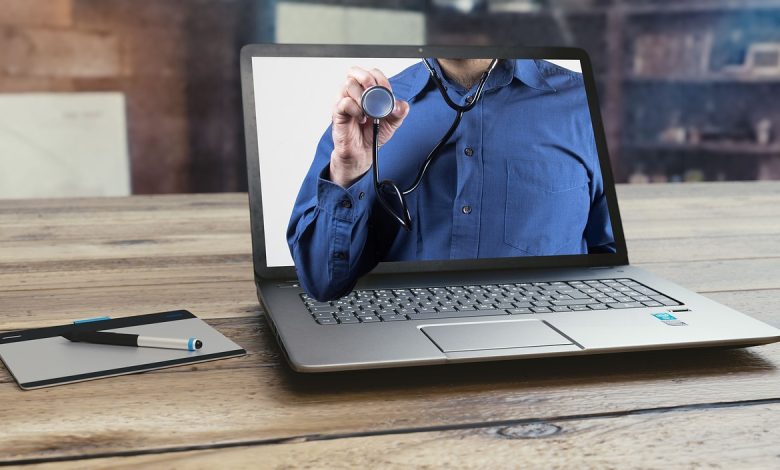What is Telemedicine? Advantages and Disadvantages

What is telemedicine?
Telemedicine refers to the use of telecommunications technology to provide healthcare services remotely. It involves the exchange of medical information from one site to another through electronic communication to improve a patient’s health.
Telemedicine can include a range of healthcare services, such as consultations, diagnoses, treatment planning, and monitoring, all conducted over a distance.
Key components of telemedicine include:
1. Video Conferencing: This allows for real-time communication between healthcare providers and patients, enabling visual assessments and discussions.
2. Telehealth Platforms: These are software and online platforms that facilitate communication between healthcare professionals and patients. They often include features for secure messaging, video consultations, and data sharing.
3. Remote Patient Monitoring (RPM): This involves the use of devices to collect patient data (such as vital signs, blood glucose levels, or activity levels) at one location and transmit it to healthcare providers at another location for monitoring and analysis.
4. Store-and-Forward: This method involves capturing and storing clinical information (such as images or videos) and then forwarding it to a healthcare provider for assessment at a later time.
Telemedicine offers several benefits, including increased access to healthcare services, reduced travel time and costs, and the ability to provide care to individuals in remote or underserved areas. It has become increasingly popular, especially during events like the COVID-19 pandemic, when in-person visits may be limited.
Telemedicine Examples
Here are some examples of how telemedicine is commonly used:
1. Video Consultations:
• A patient schedules a virtual appointment with a healthcare provider using a telehealth platform.
• The healthcare provider conducts a video consultation to discuss symptoms, review medical history, and provide advice or treatment recommendations.
2. Remote Monitoring for Chronic Conditions:
• Patients with chronic conditions, such as diabetes or hypertension, use wearable devices to monitor their vital signs.
• The data collected is transmitted to healthcare providers who can remotely monitor the patient’s condition and adjust treatment plans as needed.
3. Psychiatric Telehealth Services:
• Individuals seeking mental health support can connect with therapists or psychiatrists through video conferencing.
• This allows for therapy sessions, medication management, and ongoing support without the need for in-person visits.
4. Online Prescription Services:
• Patients can consult with healthcare providers online to receive prescription refills or obtain new prescriptions for certain medications.
• The prescriptions are electronically sent to a local pharmacy for fulfillment.
5. Telestroke Services:
• In the event of a stroke, telestroke services allow remote consultation with neurologists who can assess symptoms, review imaging results, and recommend appropriate treatment quickly.
6. Teleradiology:
• Radiologists can review and interpret medical imaging, such as X-rays, CT scans, or MRIs, remotely.
• This enables healthcare providers to receive timely diagnostic insights without the need for the patient and the radiologist to be in the same location.
7. Virtual Follow-up Visits:
• After an in-person visit or procedure, patients can have follow-up consultations with their healthcare providers through video calls.
• This helps in monitoring recovery, discussing any concerns, and making adjustments to the treatment plan.
8. Telepharmacy Services:
• Pharmacists can provide medication counseling, answer questions, and offer guidance on medication management through telepharmacy services.
9. Tele-ICU (Intensive Care Unit):
• Critical care specialists can remotely monitor patients in intensive care units using video and other technology, providing support to onsite medical teams.
These examples illustrate the diverse ways in which telemedicine is applied to enhance healthcare accessibility and efficiency. It’s important to note that the specific services and technologies may vary based on healthcare providers, regions, and regulatory frameworks.
Advantages and Disadvantages of Telemedicine
Telemedicine has gained significant traction in recent years, offering both advantages and disadvantages in the quest for accessible and efficient healthcare.
Advantages of Telemedicine:
1. Increased Access to Healthcare: Telemedicine breaks down geographical barriers, providing access to medical expertise regardless of a patient’s location. This is particularly beneficial for individuals in rural or underserved areas where healthcare facilities may be limited.
2. Convenience and Reduced Travel: Patients no longer need to endure long journeys or spend hours in waiting rooms. Telemedicine allows individuals to consult with healthcare professionals from the comfort of their homes, saving time and reducing the financial and physical burdens associated with travel.
3. Timely Consultations: Telemedicine facilitates prompt consultations, especially in urgent situations. Virtual appointments can be scheduled quickly, enabling patients to receive timely medical advice, diagnosis, or treatment recommendations.
4. Cost Savings: For both patients and healthcare providers, telemedicine can lead to cost savings. Patients save on travel expenses, and healthcare facilities can reduce overhead costs associated with maintaining physical spaces.
5. Remote Monitoring for Chronic Conditions: Telemedicine enables the continuous monitoring of patients with chronic conditions through wearable devices. This allows healthcare providers to track vital signs and adjust treatment plans in real time, promoting proactive and personalized care.
6. Improved Mental Health Services: Telemedicine plays a crucial role in delivering mental health services. It eliminates barriers to seeking therapy, offering individuals the opportunity to access mental health support from the privacy of their homes.
7. Enhanced Collaboration Among Healthcare Professionals: Telemedicine fosters collaboration among healthcare professionals, allowing specialists to consult with each other remotely. This interdisciplinary approach can lead to more comprehensive and coordinated care.
8. Reduced Transmission of Infectious Diseases: In situations such as a pandemic or during the spread of infectious diseases, telemedicine helps minimize person-to-person contact, reducing the risk of transmission.
9. Continuity of Care: Telemedicine supports the continuity of care by enabling virtual follow-up visits. Patients can maintain contact with their healthcare providers, ensuring ongoing monitoring and adjustment of treatment plans.
10. Increased Patient Engagement: Patients often feel more engaged in their healthcare when using telemedicine. The convenience of virtual consultations encourages regular check-ins, fostering a sense of ownership over one’s health.
Disadvantages of Telemedicine:
1. Technology Barriers: One of the primary challenges is the existence of technology barriers, including limited access to reliable internet, lack of digital literacy, or absence of necessary devices. This can create disparities in healthcare access, particularly among older or socioeconomically disadvantaged populations.
2. Security and Privacy Concerns: Telemedicine involves the transmission of sensitive medical information, raising concerns about data security and privacy. Ensuring robust cybersecurity measures is essential to safeguard patient information from unauthorized access or breaches.
3. Lack of Physical Examination: Remote consultations may lack the hands-on physical examination conducted during in-person visits. This limitation can affect the accuracy of diagnoses, particularly for conditions requiring direct assessment.
4. Insurance Coverage and Reimbursement Challenges: While telemedicine has expanded, challenges persist regarding insurance coverage and reimbursement. Policies may vary, and not all telehealth services may be covered, leading to financial barriers for both patients and healthcare providers.
5. Regulatory Hurdles: The regulatory landscape for telemedicine is evolving, and compliance with varying regulations across regions can be challenging. Differences in licensing requirements and telemedicine practice standards may hinder the seamless provision of services.
6. Technical Glitches and Connectivity Issues: Technical glitches, such as poor internet connectivity or software malfunctions, can disrupt telemedicine sessions, affecting the quality of communication and the overall patient experience.
7. Limited Physical Interaction: The absence of face-to-face interaction may impact the patient-provider relationship. Building trust and rapport may be challenging in a virtual setting compared to in-person consultations.
8. Scope Limitations for Certain Medical Procedures: While telemedicine is suitable for many consultations, it may not be suitable for certain medical procedures that require physical presence, such as surgery or hands-on medical interventions.
9. Resistance to Change: Both healthcare providers and patients may exhibit resistance to the shift towards telemedicine due to longstanding practices and preferences for traditional in-person care.
10. Digital Divide and Inequity: The digital divide exacerbates healthcare disparities, as individuals with limited access to technology may face barriers in utilizing telemedicine services. This can widen existing health inequities rather than narrowing them.
Telemedicine offers a myriad of advantages, revolutionizing the healthcare landscape by improving access, convenience, and efficiency. However, it is crucial to address the associated challenges, including technology barriers, security concerns, and regulatory complexities. Striking a balance between embracing technological advancements and ensuring inclusivity will be key to maximizing the potential benefits of telemedicine while minimizing its drawbacks. As the field continues to evolve, stakeholders must collaborate to shape policies that promote equitable, accessible, and high-quality telehealth services for all.
Telehealth Vs Telemedicine
Telehealth and telemedicine, though often used interchangeably, represent distinct concepts within the realm of remote healthcare services. Telehealth is the broader term, encompassing a wide spectrum of health-related activities beyond clinical care. It extends to preventive measures, health education, and administrative functions. In contrast, telemedicine is a subset of telehealth that specifically focuses on clinical services, involving medical consultations, diagnoses, and treatment planning. Telemedicine is characterized by its emphasis on leveraging technology to facilitate direct interactions between healthcare providers and patients, addressing the clinical aspects of remote healthcare delivery.
Telehealth initiatives are expansive, encompassing community health programs, public health efforts, and remote monitoring of patients through various devices. It addresses not only the treatment of existing conditions but also proactive measures to enhance overall well-being. Telemedicine, on the other hand, hones in on the clinical side, providing a platform for remote medical consultations, diagnostics, and specialist access. It is particularly valuable for follow-up visits, allowing patients to receive ongoing care without the need for frequent in-person appointments. Both telehealth and telemedicine contribute significantly to transforming healthcare delivery, leveraging technology to enhance accessibility, convenience, and the overall quality of patient care.





